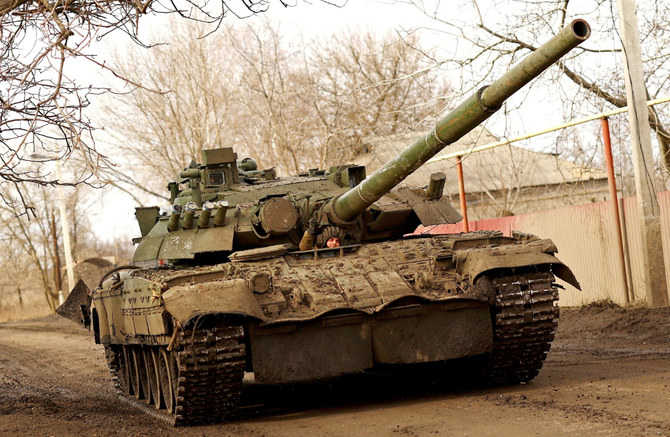CHASIV YAR, Ukraine: Russian troops and mercenaries rained artillery on the last access routes to the besieged Ukrainian city of Bakhmut on Friday, bringing Moscow closer to its first major victory in half a year after the bloodiest fighting of the war.
The head of Russia's Wagner private army said the city, which has been blasted to ruins in Russia's more than seven month onslaught, was almost completely surrounded with only one road still open for Ukraine's troops.
Reuters observed intense Russian shelling of routes leading west out of Bakhmut, an apparent attempt to block Ukrainian forces' access in and out of the city. A bridge in the adjacent town of Khromove was damaged by Russian tank shelling.
Ukrainian soldiers were working to repair damaged roads and more troops were heading towards the frontline in a sign that Ukraine was not yet ready to give up the city. To the west, Ukrainians were digging new trenches for defensive positions.
Russia's RIA state news agency released a video clip showing what it said were Wagner fighters walking by a damaged industrial facility. One fighter is heard saying Ukraine's army is destroying infrastructure in settlements near Bakhmut to prevent the Russian encirclement.
The commander of Ukraine's ground forces, Oleksandr Syrskyi, visited Bakhmut on Friday for briefings with local commanders on how to boost the defence capacity of frontline forces.
A Russian victory in Bakhmut, with a pre-war population of about 70,000, would give it the first major prize of a costly winter offensive, after it called up hundreds of thousands of reservists last year. Russia says it would be a stepping stone to capturing the surrounding Donbas industrial region, an important war aim.
Before the war Bakhmut was known for salt and gypsum mines and Ukraine says the city has little strategic value but that huge losses of troops there could shape the course of the conflict.
'PINCERS ARE CLOSING'
"Units of the private military company Wagner have practically surrounded Bakhmut," Wagner boss Yevgeny Prigozhin said in a video that Reuters determined was filmed on a rooftop in a village some 7 km (4 miles) north of the city centre.
"Only one route (out) is left," he said. "The pincers are closing."
He called on Ukrainian President Volodymyr Zelenskiy to order a retreat from Bakhmut to save his soldiers' lives. The camera panned to show three captured Ukrainians - a grey-bearded older man and two boys - asking to be allowed to go home.
The commander of a Ukrainian drone unit active in Bakhmut, Robert Brovdi who goes by the name "Madyar", said in a video posted on social media that his unit had been ordered by the military to withdraw immediately. He said he had been fighting there for 110 days.
Volodymyr Nazarenko, a deputy commander in the National Guard of Ukraine, told Ukrainian NV Radio the situation was "critical", with fighting going on "round the clock".
"They take no account of their losses in trying to take the city by assault. The task of our forces in Bakhmut is to inflict as many losses on the enemy as possible. Every metre of Ukrainian land costs hundreds of lives to the enemy," he said.
"There are many more Russians here than we have ammunition to destroy them."
MORE U.S. ARMS
The past few days have seen alarm in Russia at its own potential vulnerabilities after Moscow reported a number of drone attacks on targets deep within Russia, followed by what it said was an armed cross-border raid on Thursday.
President Vladimir Putin told his Security Council on Friday to step up "anti-terrorism measures".
Zelenskiy, for his part, visited wounded soldiers at a military hospital in Lviv. One, shaking the president's hand from bed, apologised that he could not stand up. "That's OK," Zelenskiy said. "The time will come and you will rise."
Zelenskiy gave no details of the fighting in Bakhmut during an evening video address in which he thanked troops for "firmly and bravely" defending the city.
Oleh Zhdanov, an expert on Ukraine's military, said he expected commanders would soon decide to withdraw from Bakhmut and cited unofficial reports that some units were already pulling out.
"There is a threat of being encircled," he said in a YouTube commentary posted late on Friday.
In Washington, U.S. Secretary of State Antony Blinken announced another round of military aid for Ukraine, a package of ammunition and other support valued at $400 million.
The United States has provided nearly $32 billion in aid to Ukraine since Russia's invasion on Feb. 24, 2022.
At the White House, U.S. President Joe Biden thanked visiting German Chancellor Olaf Scholz for "profound" support on Ukraine and Scholz said it was important to send the message that backing Ukraine will continue "as long as it takes and as long as is necessary."
Germany makes the Leopard tanks promised in January and expected to be the core of a new Ukrainian armoured force.
Scholz has been criticised by some Western allies for taking a cautious public stance towards arming Ukraine, although he has overseen a big shift in policy from a country that was Russia's biggest energy customer on the eve of the war.
Kyiv's ambassador in Berlin, Oleksii Makeiev, said Germany was now taking more of a leadership role in arming Ukraine.
Moscow, which says it has annexed nearly a fifth of Ukraine, accuses pro-Western Kyiv of posing a security threat. Ukraine and its allies say the invasion was an unprovoked war of conquest.
Russian Foreign Minister Sergei Lavrov, pointing to U.S. military interventions around the globe, accused the United States of hypocrisy on Friday after Blinken said Moscow cannot be allowed to wage war in Ukraine with impunity. The two men met briefly on the sidelines of a G20 foreign ministers meeting in India.















